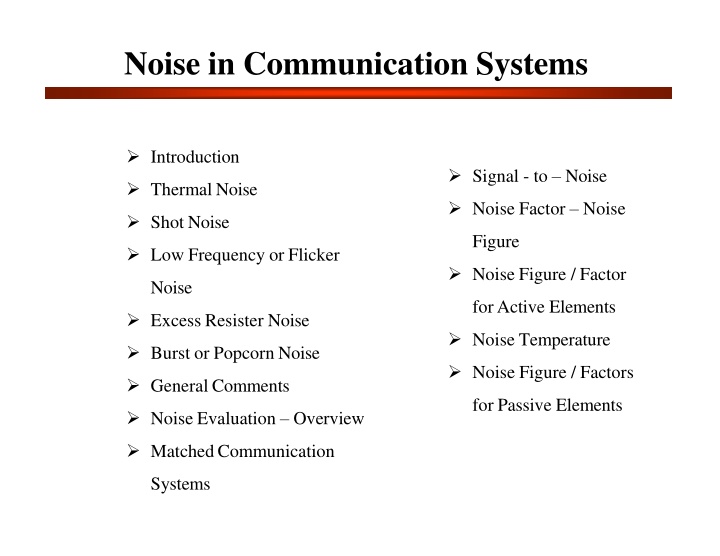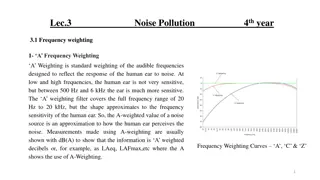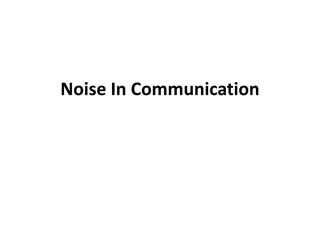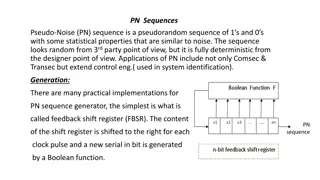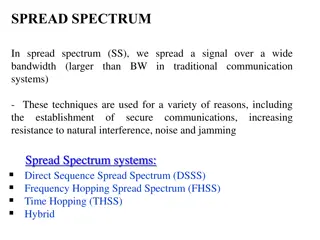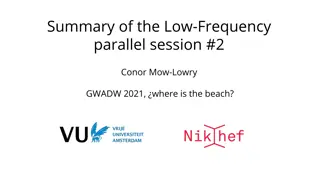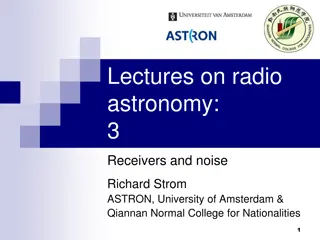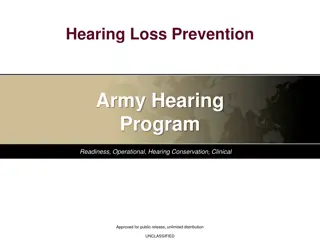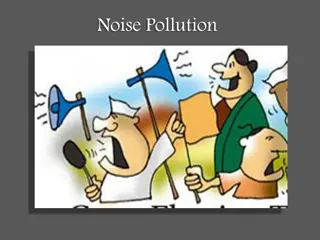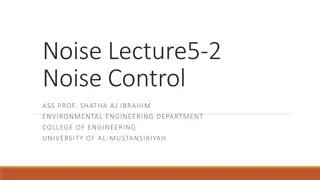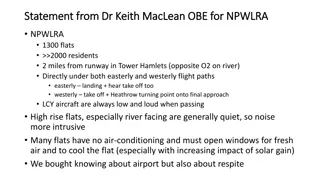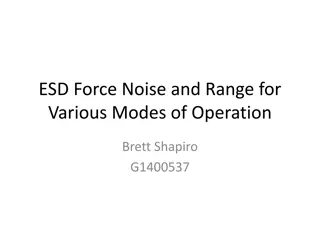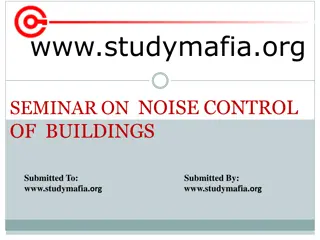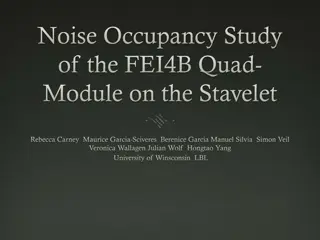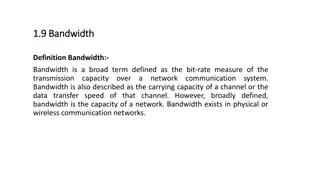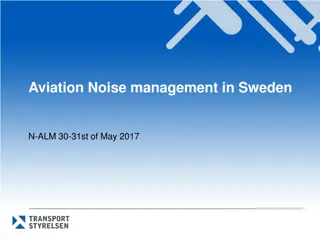Noise in Communication Systems
Noise in communication systems refers to unwanted signals that interfere with desired signals, originating from various sources such as interference from human-made sources and naturally occurring random noise. This noise can arise from factors like cross talk, power supplies, ignition systems, and atmospheric disturbances. Thermal noise, shot noise, and other types of noise impact communication systems, affecting signal quality and reliability.
Download Presentation

Please find below an Image/Link to download the presentation.
The content on the website is provided AS IS for your information and personal use only. It may not be sold, licensed, or shared on other websites without obtaining consent from the author.If you encounter any issues during the download, it is possible that the publisher has removed the file from their server.
You are allowed to download the files provided on this website for personal or commercial use, subject to the condition that they are used lawfully. All files are the property of their respective owners.
The content on the website is provided AS IS for your information and personal use only. It may not be sold, licensed, or shared on other websites without obtaining consent from the author.
E N D
Presentation Transcript
Noise in Communication Systems Introduction Signal - to Noise Thermal Noise Noise Factor Noise Shot Noise Figure Low Frequency or Flicker Noise Figure / Factor Noise for Active Elements Excess Resister Noise Noise Temperature Burst or Popcorn Noise Noise Figure / Factors General Comments for Passive Elements Noise Evaluation Overview Matched Communication Systems
1. Introduction Noise is a general term which is used to describe an unwanted signal which affects a wanted signal. These unwanted signals arise from a variety of sources which may be considered in one of two main categories:- Interference, usually from a human source (man made) Naturally occurring random noise Interference Interference arises for example, from other communication systems (cross talk), 50 Hz supplies (hum) and harmonics, switched mode power supplies, thyristor circuits, ignition (car spark plugs) motors etc.
1. Introduction (Contd) Natural Noise Naturally occurring external noise sources include atmosphere disturbance (e.g. electric storms, lighting, ionospheric effect etc), so called SkyNoise or Cosmic noise which includes noise from galaxy, solar noise and hotspot due to oxygen and water vapour resonance in the earth s atmosphere.
2. Thermal Noise (Johnson Noise) This type of noise is generated by all resistances (e.g. a resistor, semiconductor, the resistance of a resonant circuit, i.e. the real part of the impedance, cable etc). Experimental results (by Johnson) and theoretical studies (by Nyquist) give the mean square noise voltage as _ 2 V = 4 k TBR (volt 2 ) Where k = Boltzmann s constant = 1.38 x 10-23 Joules per K T = absolute temperature B = bandwidth noise measured in (Hz) R = resistance (ohms)
2. Thermal Noise (Johnson Noise) (Contd) The law relating noise power, N, to the temperature and bandwidth is N = k TB watts Thermal noise is often referred to as whitenoise because it has a uniform spectraldensity .
3. Shot Noise Shot noise was originally used to describe noise due to random fluctuations in electron emission from cathodes in vacuum tubes (called shot noise by analogy with lead shot). Shot noise also occurs in semiconductors due to the liberation of charge carriers. For pn junctions the mean square shot noise current is (I +2 I )q B I =2 2 n (amps)2 DC o e Where is the direct current as the pn junction (amps) is the reverse saturation current (amps) is the electron charge = 1.6 x 10-19 coulombs B is the effective noise bandwidth (Hz) Shot noise is found to have a uniform spectral density as for thermal noise
4. Low Frequency or Flicker Noise Active devices, integrated circuit, diodes, transistors etc also exhibits a low frequency noise, which is frequency dependent (i.e. non uniform) known as flicker noise or one over f noise. 5. Excess Resistor Noise Thermal noise in resistors does not vary with frequency, as previously noted, by many resistors also generates as additional frequency dependent noise referred to as excess noise. 6. Burst Noise or Popcorn Noise Some semiconductors also produce burst or popcorn noise with a spectral density which is proportional to 1 2 f
5. General Comments For frequencies below a few KHz (low frequency systems), flicker and popcorn noise are the most significant, but these may be ignored at higher frequencies where white noise predominates.
6. Noise Evaluation The essence of calculations and measurements is to determine the signal power to Noise power ratio, i.e. the (S/N) ratio or (S/N) expression in dB. S =S N N ratio S S = 10 log N 10 N dB Also recall that S ( mW ) = 10 log 1mW S 10 dBm N ( mW ) = 10 log and N 10 dBm 1mW i.e. S =10 log S 10 log N N 10 10 dB S =S N N dBm dBm dB
6. Noise Evaluation (Contd) The probability of amplitude of noise at any frequency or in any band of frequencies (e.g. 1 Hz, 10Hz 100 KHz .etc) is a Gaussian distribution.
6. Noise Evaluation (Contd) Noise may be quantified in terms of noise power spectral density, po watts per Hz, from which Noise power N may be expressed as N= po Bn watts Ideal low pass filter Bandwidth B Hz = Bn N= po Bn watts Practical LPF 3 dB bandwidth shown, but noise does not suddenly cease at B3dB Therefore, Bn > B3dB, Bn depends on actual filter. N= p0 Bn In general the equivalent noise bandwidth is > B3dB.
7. Matched Communication Systems In communication systems we are usually concerned with the noise (i.e. S/N) at the receiver end of the system. The transmission path may be for example:- Or An equivalent circuit, when the line is connected to the receiver is shown below.
8. Signal to Noise The signal to noise ratio is given by S =Signal Power N Noise Power The signal to noise in dB is expressed by S S =10 log 10 dB N N S =S N N dBm for S and N measured in mW. dB dBm 12. Noise Factor- Noise Figure Consider the network shown below,
9. Noise Factor- Noise Figure (Contd) The amount of noise added by the network is embodied in the Noise Factor F, which is defined by (S N ) OUT) (S Noise factor F = IN N F equals to 1 for noiseless network and in general F > 1. The noise figure in the noise factor quoted in dB e. Noise Figure F dB = 10 log10 F F 0 dB The noise figure / factor is the measure of how much a network degrades the (S/N)IN, the lower the value of F, the better the network.
9. Noise Figure Noise Factor for Active Elements For active elements with power gain G>1, we have (S N ) SIN NOUT NIN SOUT SOUT = G SIN ) (S But F = = IN N OUT Therefore NOUT F =SIN =NOUT G SIN NIN G NIN Since in general F v> 1 , then NOUT is increased by noise due to the active element i.e. Na represents added noise measured at the output. This added noise may be referred to the input as extra noise, i.e. as equivalent diagram is
9. Noise Figure Noise Factor for Active Elements (Contd) Ne is extra noise due to active elements referred to the input; the element is thus effectively noiseless.
